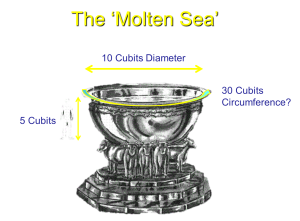On Sunday we were studying the rest of 1 Kings 7, and then chapter 8. As promised we highlighted two supposed errors in the Bible that are found in ch.7. The first is found in v.23, where we are told that the ‘molten sea’ (basically a big circular bath for the priests to wash in), was 10 cubits in diameter (a cubit is approx 18 inches). We are then told that the circumference was three times this, i.e. 30 cubits. The critics of the Bible however are quick to point out that the circumference is actually Pi x Diameter, which as I’m sure you remember from school is 3.14159 etc. 
Muslim scholar Shabbir (in his debate on 25th February 1998 against Jay Smith in Birmingham, UK) quoted this “contradiction” and added to it saying that if the bath had a diameter of 10 cubits it cannot possibly have had a circumference of 30 cubits as the text says (since ‘pi’ dictates that it would have a circumference of 31.416 or a 9.549 diameter). Shabbir made the humorous comment “Find me a bath like that and I will get baptized in it!”.
As we noted on Sunday, there is a spelling mistake in the original Hebrew text in this verse, that the Jewish scribes were wise enough to leave alone, simply putting a note of the correct spelling in the margin. As you may be aware, every Hebrew letter also represents a number. The word ‘miss-spelt’ in the text is kethiv which has a value of 111. The ‘correct’ spelling is qere which has a value of 106. So if we now do the maths: 30 x 10 x (111/106) we find that the circumference is 31.41509433962! As Dr Chuck Missler points out:
this is an error margin of less than 15 thousandths of an inch in a circumference of over 46 feet!
So if you’re a Muslim scholar, a Bible critic or just a skeptic, it might be time to get along to your nearest Bible-believing church and get baptised! The Bible really is God’s Word after all!
The rest of 1 Kings 7 gives us lots of details (which admittedly makes heavy reading) about the furnishings for the Temple. But the point here is that we realise that God is a God who cares about the little details. That means he cares about every little part of your life – and remember that if you are a Christian, the Apostle Paul says 7x in the New Testament that YOU are the Temple of the Holy Spirit. Just as the Temple was built with care and attention given to every detail, so God who has begun a good work in you, will continue it (down to the smallest detail), until the day that Jesus comes for us! (See Philippians 1:6).
We then concluded with 1 Kings 8, which is a truly remarkable chapter, as Solomon starts by standing, and ends up on his knees before God as he prays and dedicates the Temple to God. Praying specifically for the future of the Jewish people, and the Land of Israel. This is one of the longest and most passionate prayers recorded in the Bible, and serves as a good model as to how we should pray. It starts (just as Jesus does in Matthew 6:9) by focusing on the One we are praying to.
there is no God like thee, in heaven above, or on earth beneath, who keepest covenant and mercy with thy servants that walk before thee with all their heart:
Point no#1, get your eyes off yourself and onto Jesus! Solomon then recounts God’s faithfulness, which is precisely why we can confidently bring our prayers and requests to Him:
Who hast kept with thy servant David my father that thou promisedst him: thou spakest also with thy mouth, and hast fulfilled it with thine hand, as it is this day.
Point no#2, Be reminded of God’s faithfulness as recorded time and again in Scripture. Then and only then are we in a position to present our requests before Him.
Study chapter 8 for yourself, and use this and Matthew 6:9-13 as the basis and framework for your own prayers, knowing that we can ask in faith, not wavering (James 1:6).
Every blessing,
Pastor Barry.

